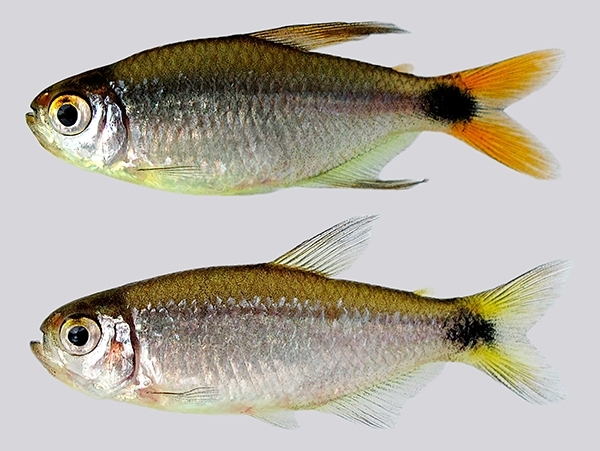

Information about the geographic distribution of over 2,300 freshwater species will be posted on the internet for use free of charge. Researchers advocate use of this knowledge to guide the planning of new hydropower developments (photo: Hyphessobrycon diastatos male (top) and female (bottom) / José Birindelli)
Information about the geographic distribution of over 2,300 freshwater species will be posted on the internet for use free of charge.
Information about the geographic distribution of over 2,300 freshwater species will be posted on the internet for use free of charge.

Information about the geographic distribution of over 2,300 freshwater species will be posted on the internet for use free of charge. Researchers advocate use of this knowledge to guide the planning of new hydropower developments (photo: Hyphessobrycon diastatos male (top) and female (bottom) / José Birindelli)
By Karina Toledo | Agência FAPESP – Changes in the habitats of endemic species of aquatic animals, as a result of cattle ranching, agriculture or the construction of dams to generate electricity in the region where several Amazon Basin tributaries rise, have caused concern that these species might disappear before they become known to science. Hence, researchers at the University of São Paulo’s Zoology Museum (MZ-USP) in Brazil have devoted years to collecting data on Characiformes, one of the world’s largest and most diversified orders of freshwater fish.
This vast group includes species with a wide variety of scales and enormously varied shapes, from tiny tetras (Astyanax spp.), which are less than 5 m long, to the Amazon tambaqui (Colossoma macropomum), which can be over 1 m long and weigh 60 kg.
One of the goals of the project, which has been in progress since 2011 with the support of FAPESP and with Professor Naércio Aquino Menezes as the principal investigator, is the publication of a free online catalog, scheduled for launch in the coming months.
This catalog will list more than 2,300 fish species that have already been described, with accurate information on their geographic distribution in South and Central America, Africa, and the southern United States.
The different species have been grouped into families according to shared characteristics. Fourteen families are currently recognized: Parodontidae (scrapetooth), Curimatidae (toothless characin), Prochilodontidae (flannel-mouthed characin), Anostomidae (leporinus), Crenuchidae (darter characin), Hemiodontidae (pencilfish), Gasteropelecidae (hatchetfish), Characidae (tetra, pacu, piranha, tambaqui, dorado, brycon), Acestrorhynchidae (shorthead drum, dog characin), Cynodontidae (dogtooth characin), Erythrinidae (wolf fish), Lebiasinidae (one-lined pencilfish, redspotted tetra), and Ctenoluccidae (pike characin).
“We do most of our field work in the headwater regions of strategically located rivers, such as the Tocantins, Paraguay, São Francisco, Xingu and Tapajós,” Menezes said. “These rivers all feed into the great Amazon Basin and are targets for the construction of new hydroelectric dams. There are always large numbers of species and even new genera in the upper parts of these rivers. The lower parts of the major basins have already been well explored.”
According to Menezes, many of the species that inhabit headwater regions are endemic and cannot live in other kinds of environment. “They tend to disappear when hydropower developments are built because the dams are usually located upstream and completely change the characteristics of this habitat. In the case of Belo Monte, we don’t even know for sure how many species have been affected. No surveys were done before construction began,” he said.
Dams can also have a detrimental effect on migratory species, he added, because these species typically swim upriver to spawn in areas near the headwaters.
For Menezes, the knowledge generated as part of the Thematic Project supported by FAPESP can be used to guide the planning of future infrastructure projects. “We’re not against development or dams,” he said. “We want these projects to be planned properly, taking the advice of specialists into account and seeking alternatives that are less harmful to the environment.”
Field work
The group led by Menezes has made six expeditions in the past five years, collecting almost 10,000 specimens from 280 fish species. They have described some 50 new species and two new genera.
The material has been added to the Zoology Museum’s existing collection and those of other institutions that participate in the South American Characiformes Inventory (SACI) project: the University of São Paulo’s Bioscience Institute (IB-USP); São Paulo State University (UNESP) in São José do Rio Preto; the Federal University of Rio Grande do Sul (UFRGS); the Ichthyology Laboratory at the Biology Department of the University of São Paulo’s Ribeirão Preto School of Philosophy, Science & Letters (FFCLRP-USP); Brazil’s National Museum in Rio de Janeiro; the United States National Museum, now the National Museum of Natural History at the Smithsonian Institution in Washington D.C.; and the Academy of Natural Sciences of Philadelphia, now of Drexel University, also in the US.
According to Menezes, degradation of aquatic ecosystems in South America is severe, and these fish species are among the most endangered.
“Biologists associated with fishery conservation and management depend on accurate taxonomic work and up-to-date records of specimens deposited in collections to determine priority areas for well-founded protection and management plans,” he said.
Republish
The Agency FAPESP licenses news via Creative Commons (CC-BY-NC-ND) so that they can be republished free of charge and in a simple way by other digital or printed vehicles. Agência FAPESP must be credited as the source of the content being republished and the name of the reporter (if any) must be attributed. Using the HMTL button below allows compliance with these rules, detailed in Digital Republishing Policy FAPESP.




